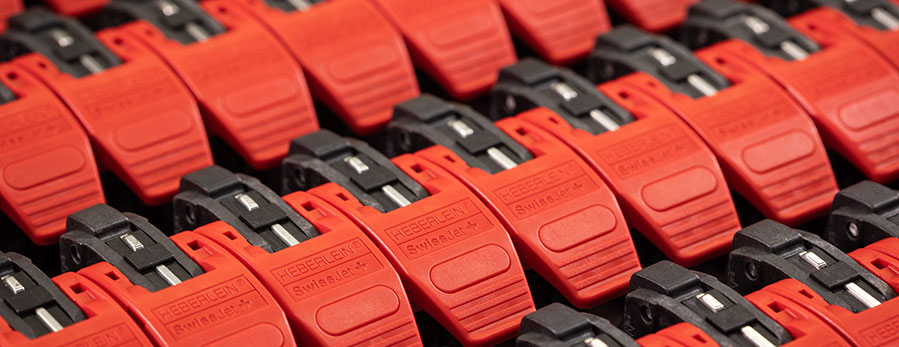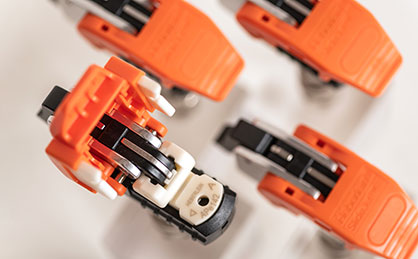Spinning
A profitable investment, ready for the upturn

Savings now and future growth: Heberlein has the facts and figures
The market already cooled notably in 2022, according to the annual International Textile Machinery Shipment Statistics (ITMSS) published last June by the International Textile Manufacturers Federation (ITMF). Shipments of draw texturing spindles declined by 13% worldwide in 2022 – with China accounting for 86% of the total. Heberlein’s own experience of past slowdowns such as those in 2007/2008 and 2020/2021 showed that business in the DTY segment always picked up again strongly afterwards.

Savings every hour
Heberlein’s launch at ITMA 2023 of the new APe series – with the capability to reduce compressed air consumption by 15% with the same number of knots – had DTY yarn producers reaching for their calculators. For example, a texturizer in Italy planning to replace a P142 jet (P-series) with an APe142 worked out cost savings of USD 120 per day for a 288-position machine with a working pressure of 3 bar. The figures were based on local electricity costs of 0.12 KWh for 1 Nm3. Effectively this was a saving of 5 dollars every hour.
As energy costs are lower in China compared to most markets, a texturizer there saves about one dollar per hour. For this calculation, Heberlein cites GlobalPetrolPrices.com and uses a price of $0.087 per kilowatt-hour (December 2022 meridian). It is also based on the industry standard for costing of 0.12 kWh for one Nm3. That means Nm3 costs one cent, while it must be mentioned that in China energy prices fluctuate locally very much and are partly massively subsidized by the state. The effective cost savings in China for a machine equipped with APe series jets (288 positions) amount to $24.3 per day on the basis of 3bar and 24 hours.
However, the figure of $24.3 must be seen in the context of a manufacturing plant in China. Staff in the production process with a 48-hour week are paid around $800 per month in the Shanghai area. With the same number of hours worked, the DTY manufacturer saves $580 per machine (288 positions) with new APe jets, which is about three-quarters of the equivalent salary of a worker.
The strategic jets
The combination of savings now while also being prepared for the upturn is a promising strategy. With the new generation of DTY air jets, the figures look good. The APe air interlacing jets are suitable for a wide variety of multifilament yarns. They achieve higher processing speeds, lead to better package build and a reduced number of filament and yarn breaks in downstream processes.
The APe series is also attracting interest from market players striving for sustainable production through various measures. For example, equal knot performance with reduced energy consumption means sustainability without compromise.
With the development and production of highly specialized key components for process optimization in processing of synthetic yarns, particularly filament yarns, Heberlein contributes significantly to increased performance by manufacturers. Using the latest flow simulations, DTY experts have gained valuable insights that have been incorporated into the development of the Advanced Performance jets. Tests in the company's own textile laboratory, as well as on-site at customer facilities, confirm the increased production performance of the new generation of jets, which also enable significant process optimization or energy savings in yarn production.
Pole position
The textile industry would obviously prefer the upswing sooner rather than later. To gain momentum rapidly and enable maximum production output, the APh interlacing jets provide the ideal starting position. The APh series meets the highest requirements for knot stability and guarantees unique performance without any compromises in yarn quality and process reliability.
The stability of the knots is also guaranteed for yarns produced by air covering in the 110 to 300 dtex range. For the finishing process, where yarns blended with elastane in particular are subjected to considerable forces, the APh jets show optimum performance. Careful analysis in the Heberlein textile laboratory also proves that the APh series offers the ideal solution, especially for low filament counts. In short, thanks to their innovative design, APh jets meet the highest requirements for knot stability for all downstream processes – knitting, warp knitting and weaving.
Next steps
Detailed calculations are essential for any investment decision, and Heberlein is happy to help prospective customers with this task. Heberlein recommends non-binding discussions with its experts – or first-hand information at ITMA Asia 2023 (Hall 8.1, Stand A43).
Useful info: when a filament yarn producer opts for lower power consumption and greater knot stability, the new APe and APh series are quick to install, as they can be fitted into the widely-used SlideJet FT15-2 and SwissJet housings. The plug-and-play principle for the APe series means replacement needs minimal effort.
